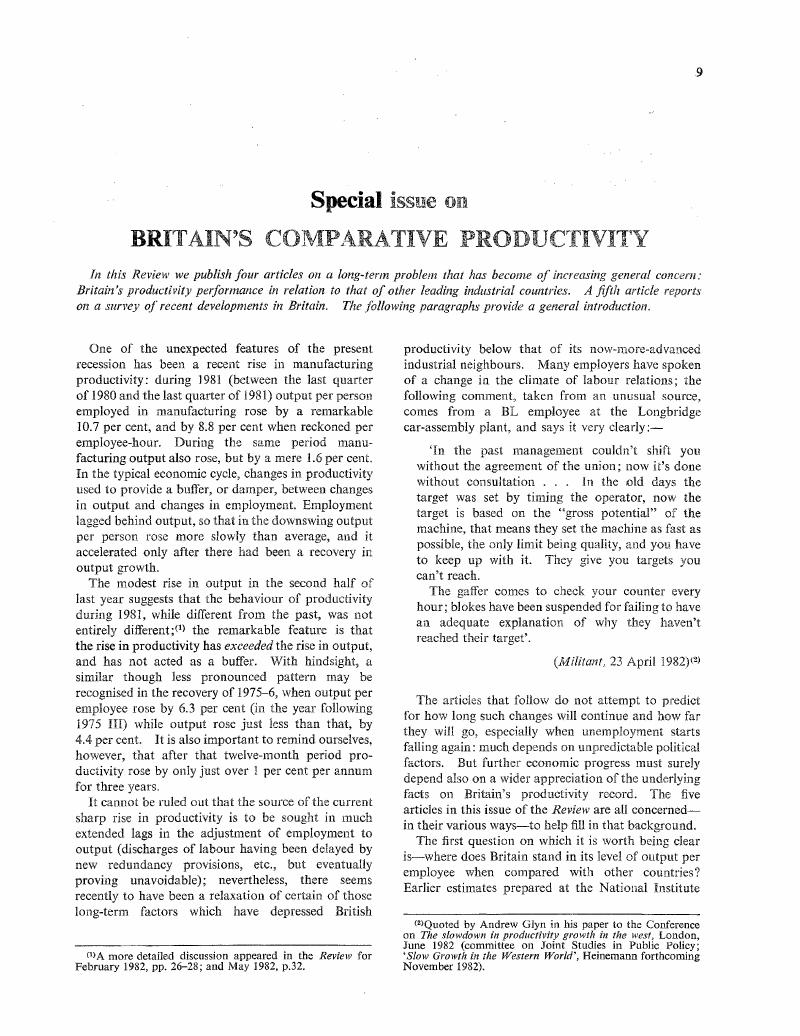Published online by Cambridge University Press: 26 March 2020

(note 1 in page 9) A more detailed discussion appeared in the Review for February 1982, pp. 26-28; and May 1982, p.32.
(note 2 in page 9) Quoted by Andrew Glyn in his paper to the Conference on The slowdown in productivity growth in the west, London, June 1982 (committee on Joint Studies in Public Policy; ‘Slow Growth in the Western World’, Heinemann forthcoming November 1982).
(note 1 in page 10) See Productivity and Industrial Structure, by S. J. Prais et al. (Cambridge, 1982), p.6.
(note 2 in page 10) I. B. Kravis, Z. Kenessy, A. Heston and R. Summers, A System of International Comparisons of Gross Product and Purchasing Power (John Hopkins University Press, 1975). See also phase II: I. B. Kravis, A. Heston and R. Summers, International Comparisons of Real Product and Purchasing Power (John Hopkins University Press, 1978).
(note 3 in page 10) Economic Trends (HMSO), April 1982, reproduces an updated table for 1980; but see footnote 2 p. 11.
(note 4 in page 10) These problems are discussed in more detail in Appendix A of Productivity and Industrial Structure, pp. 275-9.
(note 5 in page 10) ‘Output, employment and labour productivity in Europe since 1955’, by D. T. Jones, National Institute Economic Review, no. 77, August 1976, pp. 72-85.
(note 1 in page 11) The conceptual problems relating to index numbers of labour productivity are a little more complex than might be assumed from theoretical discussions of the usual ‘index number problem’ in consumption theory. The direct (economic) question that we might ask is this: as compared with Britain's actual total labour force, how many employees would be needed to produce Britain's output (distributed amongst the various industries as it actually was in a particular year), if output per employee in each industry were the same as in the US? The ratio of these two totals provides an index of relative labour productivity for the economy as a whole. Curiously enough, this is equivalent to a weighted harmonic mean of the productivity-ratios for the individual industries; it differs from the customary approach of simply comparing total GDP at fixed prices in the two countries with their total labour forces. For fuller discussion see G. J. A. Mensink, ‘Comparisons of labour producitivity in the United Kingdom and the Netherlands’, 1958, Statistical Studies No. 18 (Netherlands Central Bureau of Statistics, 1966), and the forthcoming National Institute study by A. D. Smith, D. M. W. N. Hitchens and S. W. Davies (Cambridge 1982).
(note 2 in page 11) A technical point on the alternative estimates is worth footnoting. For Germany and the US it is possible to compare the estimates derived from expenditure statistics (by Kravis et al.) with those derived from production statistics (by Smith et al.); and these seem broadly consistent. A set of estimates prepared by the Statistical Office of the European Communities for 1975 based on the expenditure approach also yielded broadly consistent results for the countries covered. That cannot however be said of the most recent estimates derived—also on the expenditure approach—by the SOEC for 1980; details of the method used have so far not been published: all that is available are the bare results published by HMSO in Economic Trends (for April 1982), reproduced from a recent OECD publication. The main difference is that Britain's GDP per head is shown some 10 per cent higher than implied by previous estimates. A full account of SOEC's methods is awaited with interest. It is however known that, in forming its multinational weights, SOEC gives equal importance to each country (whereas the study by Kravis, et al., gives more importance to a large than to a small country—a preferable procedure in our view); prices for the SOEC comparisons are collected only in the capital cities of each country, and some adjustment was made to allow for lower prices in the provinces.